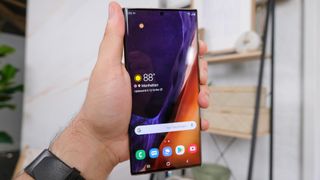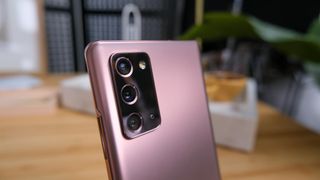Samsung Galaxy Note 20 Ultra vs. Galaxy Note 20: What you need to know
Sometimes, phones from the same product line are carbon copies of each other, with every feature save for size and price more or less the same. That’s not the case with the Samsung Galaxy Note 20 and Galaxy Note 20 Ultra. Samsung has come out with two very different phablets, from the materials it uses to the features that the phones support.
In fact, it would take less time to talk about what the Galaxy Note 20 and Note 20 Ultra have in common than to outline their differences. That’s why a Galaxy Note 20 Ultra vs Galaxy Note 20 face-off is necessary if you’re trying to decide which new Samsung phone to buy.
We’re still testing the Galaxy Note 20, but we’ve had a chance to publish our Galaxy Note 20 Ultra review, including benchmarks, photo comparisons and battery tests. Here’s a closer look at the differences between the Galaxy Note 20 and Note 20 Ultra so far.
Galaxy Note 20 vs. Galaxy Note 20 Ultra specs
| Galaxy Note 20 | Galaxy Note 20 Ultra | |
| Price | $999 | $1,299 |
| Display | 6.7-inch AMOLED (FHD; 60Hz) | 6.9-inch AMOLED (QHD; 120Hz) |
| CPU | Snapdragon 865 Plus | Snapdragon 865 Plus |
| RAM | 8GB | 12GB |
| Storage | 128GB | 128GB, 512GB |
| microSD Slot? | No | Yes |
| Rear camera | 12MP wide (ƒ/1.8); 64MP telephoto with 3x lossless zoom (ƒ/1.8); 12MP ultrawide (ƒ/2.2) | 108MP wide (ƒ/1.8); 12MP telephoto with 5x optical zoom (ƒ/3.0); 12MP ultrawide (ƒ/2.2) |
| Front camera | 10MP (ƒ/2.2) | 10MP (ƒ/2.2) |
| Battery | 4,300 mAh | 4,500 mAh |
| Battery life (Hrs:Mins) | Not yet tested | 10:26 (60Hz) / 7:59 (120Hz) |
| Charging | 25W wired; 15W wireless | 25W wired; 15W wireless |
| OS | Android 10 with One UI 2.0 | Android 10 with One UI 2.0 |
| Colors | Mystic Gray, Mystic Green, Mystic Bronze | Mystic Bronze, Mystic Black, Mystic White |
| Size | 6.36 x 2.96 x 0.32 inches | 6.48 x 3.04 x 0.32 inches |
| Weight | 6.84 ounces | 7.33 ounces |
Galaxy Note 20 vs. Galaxy Note 20 Ultra price and availability
The Galaxy Note 20 is the cheaper of Samsung’s new phablets by some measure. It’s $999, which is a $50 premium over the Galaxy Note 10 that it replaces in Samsung’s lineup.
The Galaxy Note 20 Ultra starts out $1,299, so you’re already looking at a $300 price difference between the two phones. Opt for the higher-capacity 512GB Galaxy S20 Ultra and you’re paying a total of $1,449. With that extra $450, you could pick up a new Google Pixel 4a to go with your Galaxy Note 20 and still have a c-note left over to wave at your Galaxy Note 20 Ultra-toting friend.
The price gap suggests a lot of differences between the Galaxy Note 20 vs. the Galaxy Note 20 Ultra. Let’s get into those.
Galaxy Note 20 vs. Galaxy Note 20 Ultra design
Pick up the Galaxy Note 20 and Galaxy Note 20 Ultra, and you’ll immediately notice a difference between the two phones. The Note 20 Ultra is an elegant phablet with a new fingerprint-resistant haze finish. The Note 20… goes in a different direction.

Instead of the metal and glass materials commonly associated with $1,000 flagship phones, the Note 20 uses what Samsung calls “reinforced polycarbonate.” That’s plastic by any other name, though Samsung insists it’s similarly durable to glass. Nevertheless, it feels like an odd choice for what’s supposed to be a high-end phablet.

There are other design differences beyond just the varying sizes that accommodate the phones’ respective screens. (The Note 20 Ultra is taller and wider than the standard model and weighs half-an-ounce more.) The Note 20’s display has flat edges while the Note 20 Ultra offers a more noticeable curve. Both phones sport the same IP68 rating for water resistance, though, so the differences are mostly skin deep.
Galaxy Note 20 vs. Galaxy Note 20 Ultra display
As you’d expect, Samsung has gone with different-sized OLED panels for the Note 20 and Note 20 Ultra, though these are both very large phablets. The Galaxy Note 20 has a 6.7-inch screen with Full HD resolution, while the Note 20 Ultra sports a 6.9-inch display capable of QHD resolution.

The real difference, though, lies in the screen’s refresh rate. The Galaxy Note 20 Ultra is capable of a 120Hz refresh rate — double the speed of most conventional phones, including the Note 20, which tops out at 60Hz. Even more significantly, the Note 20 Ultra uses a dynamic refresh rate, adjusting to suit whatever activity you’re doing on your phone screen. When you’re scrolling the web or playing a compatible game, the Note 20 Ultra will use the faster refresh rate, slowing down at other times. The move is meant to ease the strain on battery while still creating a more immersive experience.
During our Galaxy Note 20 Ultra testing, scrolling proved to be very smooth with Adaptive Mode turned on. Testing out Dead Trigger 2 on the optimized screen, we found the game to be very responsive.

We still need to test the Note 20’s display, but the Note 20 Ultra sets a high standard, at 662 nits of brightness. The larger Galaxy Note was able to capture 121.5% of the sRGB color gamut in Natural Mode and 201.2% in Vivid mode. Based on the Galaxy Note 20 Ultra’s Delta-E score of 0.24, those colors were pretty accurate. (Numbers closer to zero are better.)
Galaxy Note 20 vs. Galaxy Note 20 Ultra cameras
It’s impossible to compare cameras on the Galaxy Note 20 vs. the Galaxy Note 20 Ultra until we have take both phones out for a shooting session. But on paper and after our initial Note 20 Ultra tests, at least, the larger of Samsung’s phablets can claim the more impressive array of lenses.

Samsung has outfitted the Note 20 Ultra with the same main camera as the Galaxy S20 Ultra — that’s a 108MP shooter that can take very vivid photos, and a laser autofocus sensor is there to help the lens focus more reliably. Augmenting all that is a 12MP wide angle sensor and a 12MP telephoto lens that can deliver a 5x optical zoom. You can zoom up to 50x if you put your faith in the camera’s super resolution zoom, though you’ll probably want a tripod to eliminate camera shake.
Even so, we were impressed by what we saw from the Galaxy Note 20 Ultra’s telephoto lens. You can see more of our camera testing in our Galaxy Note 20 Ultra vs. iPhone 11 Pro Max camera shootout.
The power of 50x zoom. Its kind of scary. #GalaxyNote20Ultra pic.twitter.com/LpGPCuzyzGAugust 18, 2020
The Galaxy Note 20’s cameras aren’t exactly second-tier, though you will have to settle for a 12MP main sensor. For the telephoto lens, the Note 20 uses a 64MP sensor that delivers a 3x lossless zoom. A 12MP ultrawide shooter rounds out the Note 20’s trio of sensors.

Up front, both phones feature the same 10MP selfie cam, so your self-portraits should be unaffected by whichever model you purchase.
Galaxy Note 20 vs. Galaxy Note 20 Ultra performance
Here’s one area in which you won’t find much difference between the two phones. Samsung opted to equip both the Galaxy Note 20 and Note 20 Ultra with Snapdragon 865 Plus silicon. That’s the best chipset you’ll find in an Android phone, and it should help both Galaxy Notes challenge Apple’s iPhone — at least until the A14 Bionic-powered iPhone 12 models arrive later this fall.

There’s a difference in RAM — the Galaxy Note 20 has 8GB of memory to the Galaxy Note 20 Ultra’s 12GB — so you would imagine switching between apps will go smoother on the Note 20 Ultra than on the standard model. The Galaxy Note 20 Ultra will likely outperform the Note 20 on some benchmark tests when we get a chance to thoroughly review both phones, but it won’t be by much.
We’ll update this article with the Galaxy Note 20’s benchmark scores when we have them, but the Galaxy Note 20 Ultra performed well on our tests. On Geekbench 5, the Note 20 Ultra hit a multi-core score of 3,294, which is ahead of most Android phones but behind the Asus ROG Phone 3 (3,393).
The biggest difference here involves storage, and it’s a significant handicap for the Note 20. Samsung only ships that phone in a single 128GB configuration; worse, there’s no microSD card slot, so the storage that ships with the phone is all you get. You can opt for either a 128GB or 512GB version of the Galaxy Note 20 Ultra, and there’s an expansion card slot if that storage isn’t enough.
Galaxy Note 20 vs. Galaxy Note 20 Ultra battery life
Battery life could also be closer than expected between these two phones. The Galaxy Note 20 features a 4,300 mAh battery compared to a 4,500 mAh power pack in the Galaxy Note 20 Ultra. That’s not a huge difference, especially since the Note 20 Ultra has a large screen to keep powered up — and one that will be taxing the battery with a faster refresh rate on occasion.
Indeed, battery testing for the Note 20 Ultra was a mixed bag. On our battery test, which involves setting the phones to surf the web continuously over LTE until they run out of power, the Note 20 Ultra held out for 10 hours, 26 minutes. That’s above average for a phone, but it’s also with the phone set to a 60Hz refresh rate. With the 120Hz rate enabled, our Note 20 Ultra lasted a minute less than 8 hours.

You’ll find a 25W charger with either phone, which is capable of getting a drained Note 20 to a 50% charge after 30 minutes, according to Samsung. We plan to test both battery life and charging, but we’d guess that Note 20 buyers won’t feel too shortchanged here.
Galaxy Note 20 vs. Galaxy Note 20 Ultra software and special features
On the surface, this should also be a fairly comparable category. Both phones run Android 10 and both include the S Pen, the powerful stylus that really elevates the Galaxy Note experience. But Samsung tipped the scale in the favor of the Note 20 Ultra with a few extras for that larger phablet.

While both phones support new Anywhere Actions where you can make gestures with the pen to return to the home screen or go back to an opened app among other commands, Note 20 Ultra owners will enjoy a more responsive stylus. Latency for the S Pen on the Note 20 Ultra has been reduced to 9 ms, which felt as responsive as putting pen to paper. On the Note 20, you’ll get 26ms latency.
Both Note 20 models are eligible for the three-month trial subscription to Xbox Game Pass and its ability to stream more than 100 games starting in September. And if you don’t use a controller, the touch screen on the Note 20 Ultra still offers a 240Hz touch latency you won’t find on the regular Note 20.
Galaxy Note 20 vs. Galaxy Note 20 Ultra outlook
We still need to review both the Galaxy Note 20 to reach a verdict, but Samsung has given us a very distinct choice in phablets this time around. The Note 20 Ultra has established itself as standout model, with its dynamic refresh rate, more flexible storage and 108MP main camera. And that’s before you get to little differences, like the lower latency you’ll enjoy when using the S Pen.
Of course, all those premium features command a sky-high price. The question Galaxy Note 20 shoppers will have to ask themselves is whether that $300 price gap is worth it, especially if the standard Note 20 offers the same powerful processor and an impressive camera array in its own right.


